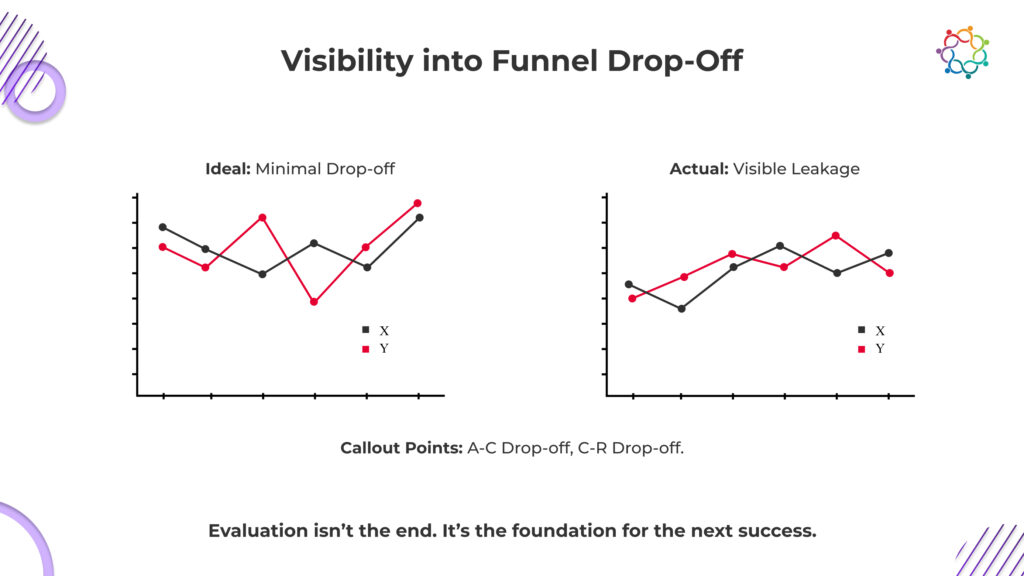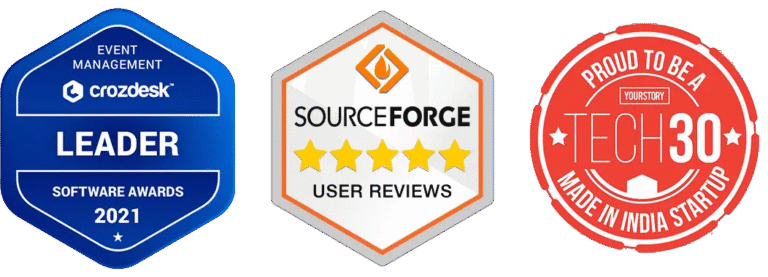Samaaro + Your CRM: Zero Integration Fee for Annual Sign-Ups Until 30 June, 2025
- 00Days
- 00Hrs
- 00Min


For many organizations, events are still treated as one-off spectacles, grand stages, packed venues, high registrations and yet little to show in terms of real, lasting impact. The applause fades, reports are filed, and the next event begins from scratch. What’s missing is continuity.
The truth is simple: awareness without conversion, and conversion without retention, equals wasted potential. That’s where an event marketing funnel transforms the equation.
Just as digital marketers build funnels that guide audiences from discovery to decision, event marketers must create a structured journey for attendees, one that nurtures initial curiosity into engagement, and ultimately into long-term loyalty.
When a defined funnel framework is in place, events evolve from isolated campaigns into sustained growth engines. Every touchpoint from the first RSVP to post-event engagement, contributes to measurable outcomes.
In short, funnel thinking creates strategic continuity across the event lifecycle. It ensures that every rupee invested at the awareness stage ultimately drives tangible business value through conversions and retention turning every event into a compounding asset rather than a single-use campaign.
Awareness relates to the ability to be seen and discovered; to reach the right audience, in the right place, and say the right thing to them. It is not simply enough to be loud; you must be intentional about how you authentically connect with them.
Key Tactics
Paid Media: The use of hyper-targeted ads in google, meta and LinkedIn allows you to reach segmented persona profile either they be those are home buyers, doctors, or CXOs.
Influencer & Speaker Promotions – A trusted voice promoting your event adds trust to a connection that no banner ad can offer.
Thought Leadership Content – Blogs, teaser videos, and speaker reveals are giving value to authority and creating anticipation
Email Drip Campaigns: Reach out to previous guests and prospects with personalization like “Come back to learn exclusive information.”
Metrics that matter:
Example:
A SaaS company with a new product in automation partnered with LinkedIn micro-influencers in the B2B tech field. Instead of telling everyone to attend the event, those micro-influencers expressed how excited they were to attend and shared their thoughts on industry challenges while they were at it which implicitly tied back to the posted event. The net result was a 2.3x increase in registrations and no increase in advertising budgets while also bolstering their presence in an engaged thought leadership space.
Pro Tip: Awareness is not being everywhere. Awareness is being in the channels your audience trusts.

Once awareness has peaked, that leads us to the next obstacle: turning intent into action. Action into registrations. Registrations into attendance. Interest into expressions of interest. The conversion stage is where intent can become tangible and measurable.
But here is where most event marketers stumble. Users fill out the form, but they don’t show up. We capture leads, but they don’t get followed up. Conversion is converting attention into engagement, engagement into attendance, and attendance into revenue (or outcomes and strikes).
How do we do that?
Key Tactics:
Automate RSVP systems: Make it easier for the guest to confirm attendance. Every extra click…. every extra click equals a decreased likelihood the user will attend.
Remind with purpose: Instead of sending a generic reminder with “Don’t forget our event!” use reminders & prompts that reiterate value you’ll deliver- “Your session with Dr. Rao on AI in Healthcare starts at 10 AM!”
Previews: Provide early previews of agenda or speaker clips to build excitement.
Retarget: Use paid media or emails to retarget users who visited but did not register.
Key Metrics:
Example:
A real estate developer at a luxury property show was experiencing very low EOI rates, despite high attendance. They incorporated Samaaro’s event marketing platform, allowing for digital, QR-based registrations and engaged with automated WhatsApp follow-up messaging attendees to submit their EOIs before they left. The result? 20% of attendees submitted EOIs on-site and 35% of attendees closed following the event.
Pro Tip: Treat conversions like a conversation rather than a transaction; every touchpoint should instil confidence and remove friction.
If the conversion is the spark of event engagement, retention becomes the flame that sustains it. A good number of brands fail to continue to engage the attendee after the event, losing the potential for a valuable long-term relationship that leads to repeat attendance or referrals.
Retention is where event ROI can create the impact because a past attendee will cost significantly less to engage than a new attendee. Especially in the BFSI, healthcare, or real estate industry, retention is indicative of customer loyalty and long-term advocacy.
Key Tactics:
Content hubs for post-event engagement: Send out recordings of sessions, highlight reels, and follow-up guides to continue sharing knowledge with attendees, making it easy for them to revisit several sessions, and learn.
Nurture campaigns: Send segmented post-event emails based on who they are post-event, for example, investors, doctors, agents, or buyers.
Feedback loops: Follow up with a post-event survey and NPS form, to obtain satisfaction ratings and key insights on improvement.
VIP Benefits: Acknowledge your superstars with VIP access, early notifications to events, or rewards for referring others to attend.
The Metrics That Matter:
Example:
This major BFSI brand turned its yearly investor conference into a digital community that is now active from year to year. Attendees can receive content that is personalized for some content historians such as a quarterly invite to a virtual content pertinent to them. Ultimately, this engagement increased 25% retention of investors, and attendance had doubled for their next conference.
Pro Tip: Retention starts before the event even ends. Always let the participants know they will be receiving content in the future, or some other interactive experience that will reach them in the future, while the engagement is at a high point.

A well-built event marketing funnel isn’t just about strategy; it depends on the right tools at every stage. From attracting the right audience to converting leads and nurturing relationships post-event, technology keeps the funnel measurable and efficient.
For Awareness:
Use marketing automation tools and event CRMs to manage multi-channel outreach. Platforms that integrate with email, ads, and landing pages help track which sources drive the highest registrations. Real-time analytics dashboards ensure campaigns are optimized before the event even begins.
For Conversion:
Integrate your CRM directly with the event registration and check-in systems. This sync ensures every attendee interaction, RSVP, demo request, EOI, is captured instantly. Automation tools can trigger personalized reminders, confirmations, and pre-event engagement sequences to improve attendance rates.
For Retention:
Post-event engagement tools such as branded learning hubs, content libraries, and follow-up campaigns keep participants connected. Surveys and NPS trackers help gauge satisfaction, while analytics dashboards show who re-engages with your content, identifying the most valuable long-term prospects.
To build and refine this funnel effectively, marketers need more than tactics, they need a strategy grounded in measurable outcomes. That’s where advanced event marketing frameworks come in. By integrating CRM tools for conversion tracking, using analytics dashboards to identify drop-offs, and maintaining post-event learning hubs for retention, organizers can turn insight into action. For a deeper look at how modern marketers are building data-driven event funnels, explore Samaaro’s Event Marketing 2025 Guide.
Samaaro is an AI-powered event marketing platform that helps teams operationalize the full-funnel event model, from the first click to long-term participant retention. Instead of managing fragmented tools, marketers can plan, automate, and analyze the entire attendee journey on a single platform.
Key Capabilities
Example in Action
During a multi-location product experience campaign, a SaaS company used Samaaro to monitor its complete event funnel across four regions. The platform connected attendee engagement data, such as participation in product demos, directly with sales outcomes. Insights showed that attendees who engaged in live demonstrations were 45% more likely to convert within 30 days.
With Samaaro, the brand could quantify engagement impact, linking event participation directly to pipeline growth and measurable revenue outcomes.
Most successful brands emerging in 2026 are brands who treat events as continuous or sections of funnels with each event forefronts environment request toward engagement allow engagement around their performance and ROI.
This allows all of these includes into analytics future engagement marketing.
The future of event marketing is measuring, cyclical, intent across the ROI.
Do you want to create an event funnel that gets measuring ROI, then schedule a demo on Samaaro driven Event marketing platform.

Built for modern marketing teams, Samaaro’s AI-powered event-tech platform helps you run events more efficiently, reduce manual work, engage attendees, capture qualified leads and gain real-time visibility into your events’ performance.


© 2025 — Samaaro. All Rights Reserved.